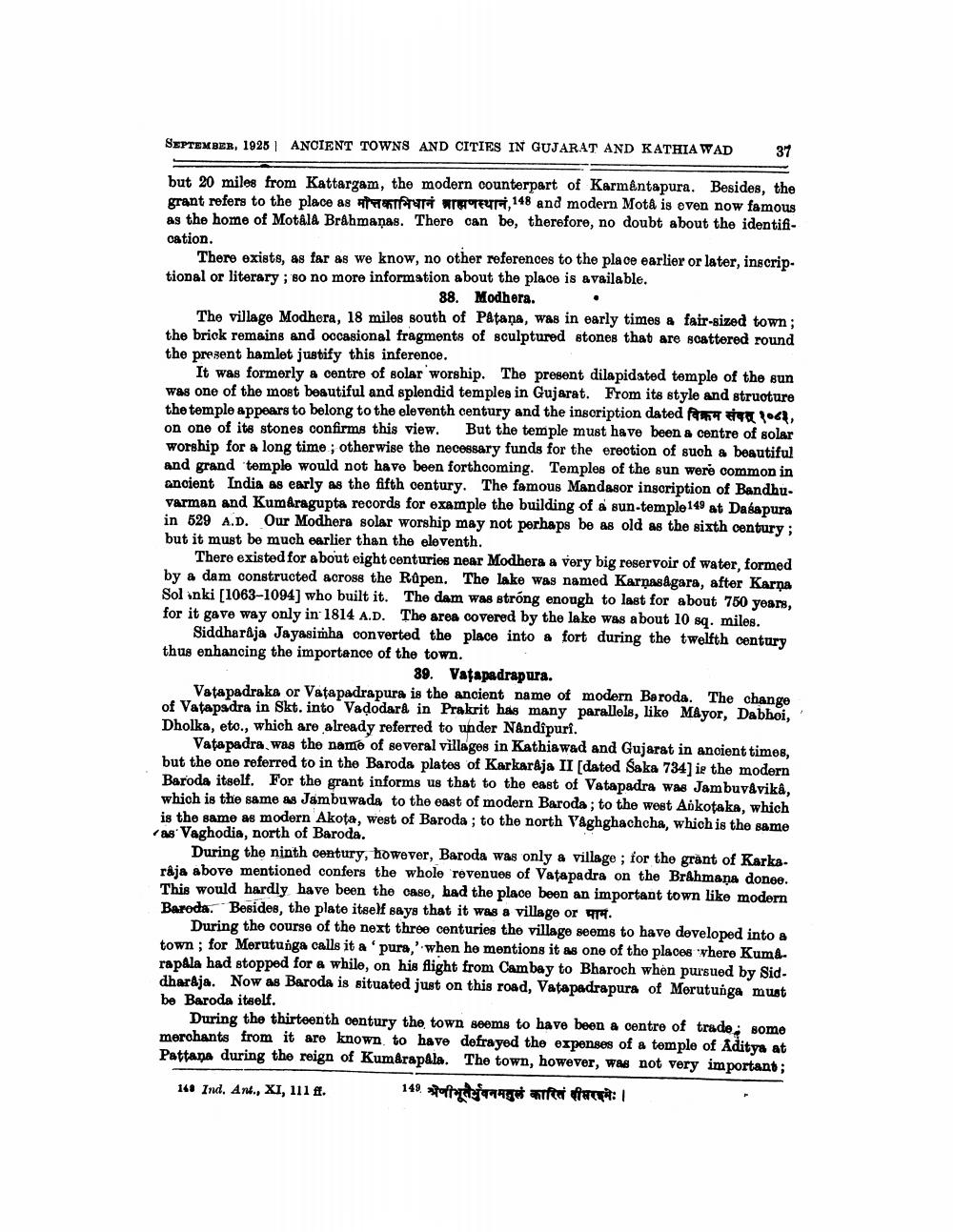________________
SEPTEMBER, 1928 ANCIENT TOWNS AND CITIES IN GUJARAT AND KATHIA WAD
37
but 20 miles from Kattargam, the modern counterpart of Karmêntapura. Besides, the grant refers to the place as a
WATEUR, 148 and modern Mota is even now famous as the home of Motala Brahmanas. There can be, therefore, no doubt about the identification.
There exists, as far as we know, no other references to the place earlier or later, inscriptional or literary; so no more information about the place is available.
88. Modhera. The village Modhera, 18 miles south of Patana, was in early times a fair-sized town; the brick remains and occasional fragments of sculptured stones that are scattered round the present hamlet justify this inference.
It was formerly a contre of solar worship. The present dilapidated temple of the sun was one of the most beautiful and splendid temples in Gujarat. From its style and struoture the temple appears to belong to the eleventh century and the inscription dated
1061, on one of its stones confirms this view. But the temple must have been a centre of solar worship for a long time; otherwise the necessary funds for the erection of such a beautiful and grand temple would not have been forthcoming. Temples of the sun were common in ancient India as early as the fifth oentury. The famous Mandasor inscription of Bandhuvarman and Kum Aragupta records for example the building of a sun-temple149 at Dasapura in 629 A.D. Our Modhera solar worship may not perhaps be as old as the sixth century; but it must be much earlier than the eleventh.
There existed for about eight centuries near Modhera a very big reservoir of water, formed by a dam constructed across the Râpen. The lake was named Karnasagara, after Karna Solanki [1063-1094) who built it. The dam was strong enough to last for about 750 years, for it gave way only in 1814 A.D. The area covered by the lake was about 10 sq. miles.
Siddharaja Jayasimha converted the place into a fort during the twelfth century thus enhancing the importance of the town.
89. Vatapadrapura. Vatapadraka or Vatapadrapura is the ancient name of modern Baroda. The change of Vatapadra in Skt. into Vadodara in Prakrit has many parallels, like M&yor, Dabhoi, Dholka, eto., which are already referred to under Nandipuri.
Vatapadra was the name of several villages in Kathiawad and Gujarat in ancient times, but the one referred to in the Baroda plates of Karkardja II (dated Saka 734) ie the modern Baroda itself. For the grant informs us that to the east of Vatapadra was Jam buvdvika, which is the same as Jambuwada to the east of modern Baroda ; to the west Avkotaka, which is the same as modern Akota, west of Baroda ; to the north Vaghghachcha, which is the same as Vaghodia, north of Baroda.
During the ninth century, however, Baroda was only a village ; for the grant of Karka. råja above mentioned confers the whole revenues of Vatapadra on the Brahmaņa donce. This would hardly have been the case, bad the place been an important town like modern Baroda. Besides, the plate itself says that it was a village or 44.
During the course of the next three centuries the village seems to have developed into a town; for Merutunga calls it a 'pura,' when he mentions it as one of the places where Kumarapala had stopped for a while, on his flight from Cambay to Bharoch when pursued by Sid. dharaja. Now as Baroda is situated just on this road, Vatapadrapura of Morutunga must be Baroda itself.
During the thirteenth century the town seems to have been a centre of trade, some merchants from it are known to have defrayed the expenses of a temple of Aditya at Pattana during the reign of Kumarapala. The town, however, was not very important; 14. Ind. Ant., XI, 111 ff.
149. stoletja ng affeci:




